
(a)
Interpretation:
Considering vapor-compression refrigeration cycle and different
Concept introduction:
Below shown diagram represents vapor-compression refrigeration cycle on a
The line
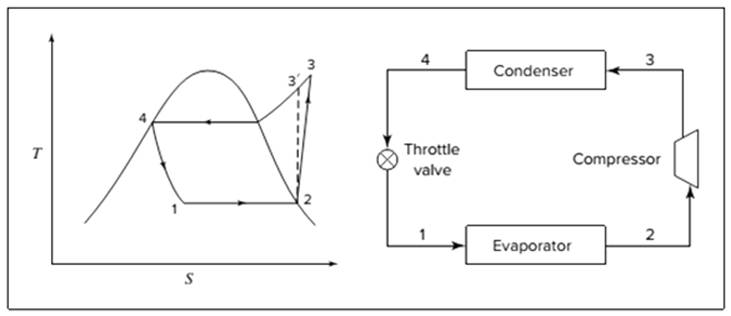
The equations used to calculate the heat absorbed in evaporator and the heat rejected in condenser are:
The work of compression is:
The coefficient of performance is:
The rate of circulation of refrigerant,
For Carnot refrigeration cycle, highest possible value of
(a)
Answer to Problem 9.9P
Explanation of Solution
Given information:
The refrigerant is tetrafluoroethene.
Evaporation
Condensation
Refrigeration rate is
The given data for the vapor-compression cycle are:
From table 9.1, the values of
For isentropic compression,
The saturation pressure at point 4 is the pressure at which the vapor condenses which is
At point
Calculate the value of
Now, calculate
Also,
Use equation (5) to calculate the value of
Use equation (2) to calculate the value of
Since,
The work done is calculated as:
Use equation (5) to calculate the coefficient of performance for vapor-compression cycle as:
For Carnot cycle, the coefficient of performance is calculated as:
(b)
Interpretation:
Considering vapor-compression refrigeration cycle and different thermodynamic processes taking place between two stages, the circulation rate of refrigerant, the heat transfer rate in the condenser, the power requirement, the coefficient of performance of the cycle and the coefficient of performance of a Carnot refrigeration cycle are to be calculated.
Concept introduction:
Below shown diagram represents vapor-compression refrigeration cycle on a
The line
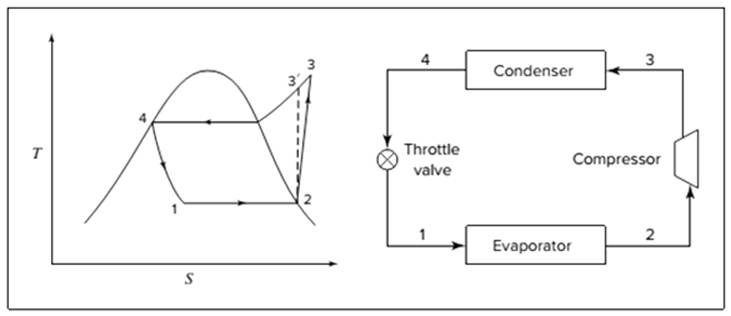
The equations used to calculate the heat absorbed in evaporator and the heat rejected in condenser are:
The work of compression is:
The coefficient of performance is:
The rate of circulation of refrigerant,
For Carnot refrigeration cycle, highest possible value of
(b)
Answer to Problem 9.9P
Explanation of Solution
Given information:
The refrigerant is tetrafluoroethene.
Evaporation
Condensation
Refrigeration rate is
The given data for the vapor-compression cycle are:
From table 9.1, the values of
For isentropic compression,
The saturation pressure at point 4 is the pressure at which the vapor condenses which is
At point
Calculate the value of
Now, calculate
Also,
Use equation (5) to calculate the value of
Use equation (2) to calculate the value of
Since,
The work done is calculated as:
Use equation (5) to calculate the coefficient of performance for vapor-compression cycle as:
For Carnot cycle, the coefficient of performance is calculated as:
(c)
Interpretation:
Considering vapor-compression refrigeration cycle and different thermodynamic processes taking place between two stages, the circulation rate of refrigerant, the heat transfer rate in the condenser, the power requirement, the coefficient of performance of the cycle and the coefficient of performance of a Carnot refrigeration cycle are to be calculated.
Concept introduction:
Below shown diagram represents vapor-compression refrigeration cycle on a
The line
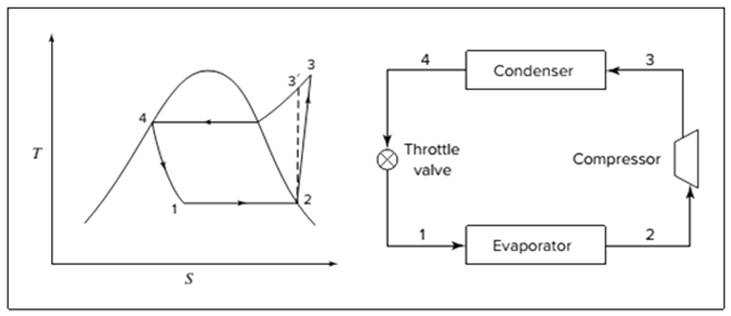
The equations used to calculate the heat absorbed in evaporator and the heat rejected in condenser are:
The work of compression is:
The coefficient of performance is:
The rate of circulation of refrigerant,
For Carnot refrigeration cycle, highest possible value of
(c)
Answer to Problem 9.9P
Explanation of Solution
Given information:
The refrigerant is tetrafluoroethene.
Evaporation
Condensation
Refrigeration rate is
The given data for the vapor-compression cycle are:
From table 9.1, the values of
For isentropic compression,
The saturation pressure at point 4 is the pressure at which the vapor condenses which is
At point
Calculate the value of
Now, calculate
Also,
Use equation (5) to calculate the value of
Use equation (2) to calculate the value of
Since,
The work done is calculated as:
Use equation (5) to calculate the coefficient of performance for vapor-compression cycle as:
For Carnot cycle, the coefficient of performance is calculated as:
(d)
Interpretation:
Considering vapor-compression refrigeration cycle and different thermodynamic processes taking place between two stages, the circulation rate of refrigerant, the heat transfer rate in the condenser, the power requirement, the coefficient of performance of the cycle and the coefficient of performance of a Carnot refrigeration cycle are to be calculated.
Concept introduction:
Below shown diagram represents vapor-compression refrigeration cycle on a
The line
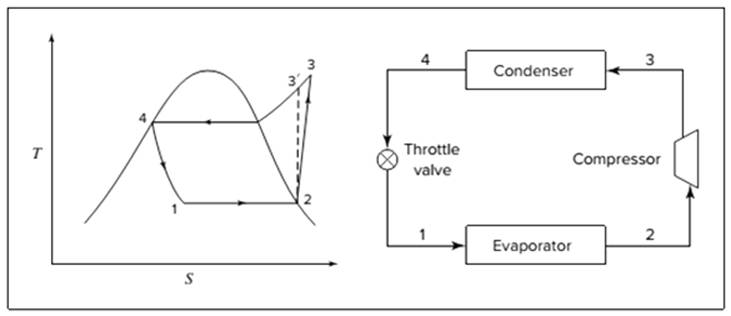
The equations used to calculate the heat absorbed in evaporator and the heat rejected in condenser are:
The work of compression is:
The coefficient of performance is:
The rate of circulation of refrigerant,
For Carnot refrigeration cycle, highest possible value of
(d)
Answer to Problem 9.9P
Explanation of Solution
Given information:
The refrigerant is tetrafluoroethene.
Evaporation
Condensation
Refrigeration rate is
The given data for the vapor-compression cycle are:
From table 9.1, the values of
For isentropic compression,
The saturation pressure at point 4 is the pressure at which the vapor condenses which is
At point
Calculate the value of
Now, calculate
Also,
Use equation (5) to calculate the value of
Use equation (2) to calculate the value of
Since,
The work done is calculated as:
Use equation (5) to calculate the coefficient of performance for vapor-compression cycle as:
For Carnot cycle, the coefficient of performance is calculated as:
(e)
Interpretation:
Considering vapor-compression refrigeration cycle and different thermodynamic processes taking place between two stages, the circulation rate of refrigerant, the heat transfer rate in the condenser, the power requirement, the coefficient of performance of the cycle and the coefficient of performance of a Carnot refrigeration cycle are to be calculated.
Concept introduction:
Below shown diagram represents vapor-compression refrigeration cycle on a
The line
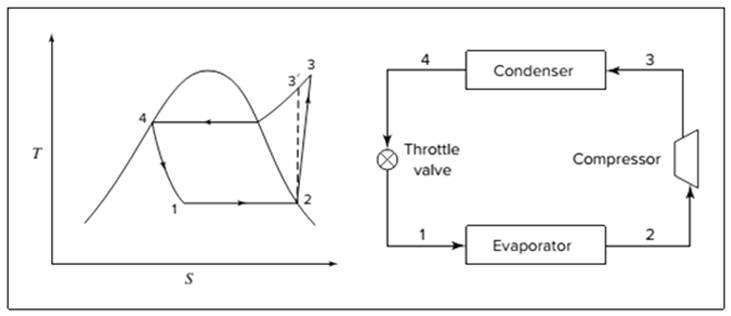
The equations used to calculate the heat absorbed in evaporator and the heat rejected in condenser are:
The work of compression is:
The coefficient of performance is:
The rate of circulation of refrigerant,
For Carnot refrigeration cycle, highest possible value of
(e)
Answer to Problem 9.9P
Explanation of Solution
Given information:
The refrigerant is tetrafluoroethene.
Evaporation
Condensation
Refrigeration rate is
The given data for the vapor-compression cycle are:
From table 9.1, the values of
For isentropic compression,
The saturation pressure at point 4 is the pressure at which the vapor condenses which is
At point
Calculate the value of
Now, calculate
Also,
Use equation (5) to calculate the value of
Use equation (2) to calculate the value of
Since,
The work done is calculated as:
Use equation (5) to calculate the coefficient of performance for vapor-compression cycle as:
For Carnot cycle, the coefficient of performance is calculated as:
Want to see more full solutions like this?
Chapter 9 Solutions
GEN, ORG & BIOL CHEM: CUSTOM SSC
 Introduction to Chemical Engineering Thermodynami...Chemical EngineeringISBN:9781259696527Author:J.M. Smith Termodinamica en ingenieria quimica, Hendrick C Van Ness, Michael Abbott, Mark SwihartPublisher:McGraw-Hill Education
Introduction to Chemical Engineering Thermodynami...Chemical EngineeringISBN:9781259696527Author:J.M. Smith Termodinamica en ingenieria quimica, Hendrick C Van Ness, Michael Abbott, Mark SwihartPublisher:McGraw-Hill Education Elementary Principles of Chemical Processes, Bind...Chemical EngineeringISBN:9781118431221Author:Richard M. Felder, Ronald W. Rousseau, Lisa G. BullardPublisher:WILEY
Elementary Principles of Chemical Processes, Bind...Chemical EngineeringISBN:9781118431221Author:Richard M. Felder, Ronald W. Rousseau, Lisa G. BullardPublisher:WILEY Elements of Chemical Reaction Engineering (5th Ed...Chemical EngineeringISBN:9780133887518Author:H. Scott FoglerPublisher:Prentice Hall
Elements of Chemical Reaction Engineering (5th Ed...Chemical EngineeringISBN:9780133887518Author:H. Scott FoglerPublisher:Prentice Hall
 Industrial Plastics: Theory and ApplicationsChemical EngineeringISBN:9781285061238Author:Lokensgard, ErikPublisher:Delmar Cengage Learning
Industrial Plastics: Theory and ApplicationsChemical EngineeringISBN:9781285061238Author:Lokensgard, ErikPublisher:Delmar Cengage Learning Unit Operations of Chemical EngineeringChemical EngineeringISBN:9780072848236Author:Warren McCabe, Julian C. Smith, Peter HarriottPublisher:McGraw-Hill Companies, The
Unit Operations of Chemical EngineeringChemical EngineeringISBN:9780072848236Author:Warren McCabe, Julian C. Smith, Peter HarriottPublisher:McGraw-Hill Companies, The





